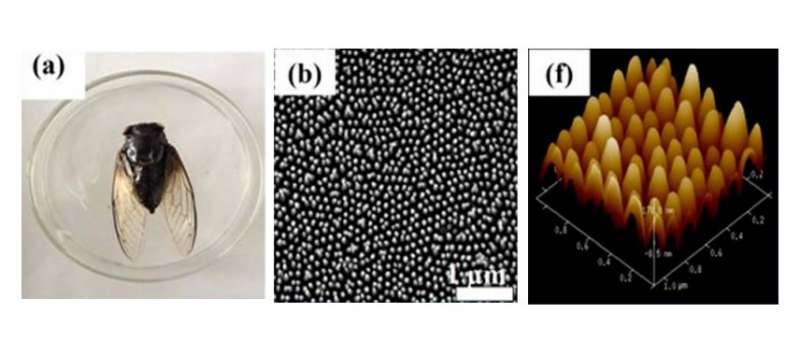(Left) Photograph of a cicada, (center) SEM image of nanostructures on cicada wings, and (right) 3D AFM image of cicada wings. Credit: Zada et al. ©2017 American Institute of Physics
(Phys.org)—Researchers have turned to cicada wings to design surfaces with highly antireflective properties, which have potential applications for solar cells, stealth surfaces, antifogging materials, and other optical applications.
As researchers Imran Zada et al. at Shanghai Jiao Tong University in China explain in a recent issue of Applied Physics Letters, cicada wings have nanoscale structures that give them exceptional antireflective properties, allowing them to transmit or absorb close to 100% of visible light. When it comes to solar cells, antireflective properties play an important role since absorbing more light leads to a better overall performance.
In their paper, the researchers explain how they fabricated a silicon dioxide surface (an inexpensive material that is commonly used to make windows and camera lenses) with the same nanostructured pattern as cicada wings (which are made mostly of chitin) by using the wings as a template. By treating biological cicada wings in a solution containing silicon dioxide, then exposing the treated wings to high-intensity ultrasound, and finally allowing the wings to solidify so that the wings can be separated from the silicon dioxide material, the researchers were able to fabricate biomorphic silicon dioxide surfaces with the same nanostructured pattern that the cicada wings have.
"Our work demonstrates that silicon dioxide with an antireflective structure can be directly fabricated from cicada wings through a simple and inexpensive sol-gel assisted ultrasonic method," coauthor Wang Zhang at Shanghai Jiao Tong University told Phys.org. "The material exhibits a high performance of antireflective properties in the visible wavelength range at a wide range of incident angles."
Tests revealed that the new surfaces have a very low reflectance, absorbing as little as 0.3% of visible light. The reflectance properties vary depending on the incident angle of the light, however, and increase to 3.3% with increasing incident angles of the light. The researchers explain that the good antireflection properties arise due to the nanostructured pattern of the wings, in which the nanostructures' dimensions are smaller than the wavelength of light. This pattern creates a continuously graded refractive index profile from air to the material's surface, which essentially provides a pathway for light rays to enter the material and prevents them from reflecting back out.
Although cicada wings are naturally superhydrophobic, the researchers were able to tune this property on the silicon dioxide surface by changing its chemical composition, transforming it into a hydrophilic material. With hydrophilic properties, the surface easily forms hydrogen bonds with water molecules. Combined with the material's antireflective properties, this has the effect of preventing fog formation, suggesting potential applications for anti-fogging and self-cleaning optical materials. The researchers plan to explore these kinds of applications in future work.
"In the future, our work is headed toward fabricating high-refractive-index materials with antireflective structures to study their multifunctional properties, such as antireflection, antibacterial activity, and superhydrophobicity," Zhang said.
More information: Imran Zada et al. "Multifunctional, angle dependent antireflection, and hydrophilic properties of SiO2 inspired by nano-scale structures of cicada wings." Applied Physics Letters. DOI: 10.1063/1.4986133
Journal information: Applied Physics Letters
© 2017 Phys.org
























